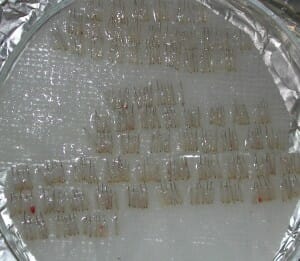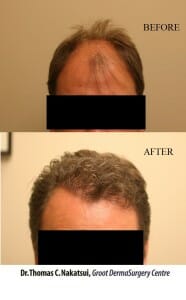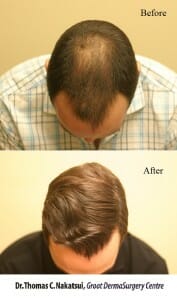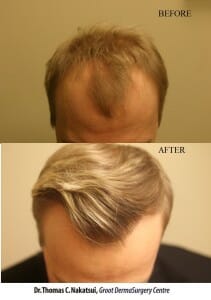The Art of Hair Restoration Surgery
Hair transplant surgeries have become one of the most popular cosmetic procedures for men and a large number of women. Much of what happens before, during, and after a hair transplant surgery is uncertain for many curious people. Here is what the typical process for hair restoration surgeries look like from consultation to 1 year after the surgery with Dr. Nakatsui.
Complimentary Comprehensive Consultation
A prospective patient will come in to our clinic for a complimentary consultation with Dr. Nakatsui. During this consultation, Dr. Nakatsui will obtain a thorough history of the individual. When did the hair loss begin, what types of treatments they have tried in the past, and what is their family history for hair loss are among a few of the typical questions asked.
Dr. Nakatsui then performs a thorough examination of the scalp to determine if there are any other medical factors that may contribute to the hair loss such as Alopecia Areata or Lichen Planopilaris. These are conditions in which the body attacks its own hair and because of that, hair transplantation into these areas is not recommended. Dr. Nakatsui then assesses the patient’s situation and expectations and determines if the individual is a good candidate for hair restoration surgery.
Candidacy for hair restoration surgery is multifactorial. First, Dr. Nakatsui will assess if there is enough donor hair for the required areas. Is there enough supply for the demand? Donor hair taken from the back of the scalp is the best hair for transplantation and we have to think of that hair as a limited resource; there is only so much that Dr. Nakatsui can take from this resource. Candidacy goes beyond the initial consultation as well. Dr. Nakatsui will not only take into consideration if there is enough donor supply for the demand for today, but also for next year, 10 years down the road.
Unfortunately, hair loss in men and women may be progressive and can continue for many years after a hair transplant. Technically, the transplanted hairs are permanent and should never fall out, so that leaves the pre-existing non-transplanted hairs. These hairs have the potential to fall out in the future. Dr. Nakatsui takes these factors into account and tries to determine if there will be sufficient supply to meet the demands of the future.
The most important factor for candidacy is always patient expectations. The goal of hair transplant surgeries, and any cosmetic surgery, is improvement not perfection. Since the transplanted hairs are technically permanent, they will be with you when you are 70-80 years old. It is important to understand that having a low hair-line similar to your 18-year-old self may have an unnatural appearance not only today, but when you are 70 years old.
Hair transplant surgeries can take several hours to perform as it is very detailed and tedious work. Similar to a master watch maker crafting a beautiful watch, Dr. Nakatsui skilfully and painstakingly performs surgery that will ultimately yield incredible results.
Surgery Day
The big day is finally here and there is excitement in the air! Patients arrive at 8:00 in the morning and is shown around our clinic. Dr. Nakatsui speaks with the patient going through all the ins and outs of the procedure. Dr. Nakatsui then plots out exactly where he will be transplanting and ensures that both patient and Dr. Nakatsui are happy with the recipient areas.
The patient is prepped and ensured the donor and recipient areas are clean and sterile. At this time, the patient is laying face down in a comfortable massage table and Dr. Nakatsui at this will use local anaesthetic to numb up the donor site. If the patient is having the follicular unit transplant (strip technique), then Dr. Nakatsui and his surgical team slowly and carefully remove the donor site hair. Once that is complete, he then closes the donor site with surgical staples.
If a follicular unit extraction (FUE – individual) surgery is performed, Dr Nakatsui will trim the donor site hair very short. Local anaesthetic is used once again to numb up the area, then using a tool called the SAFE machine, Dr. Nakatsui manually extracts every individual hair one by one.
 Once the removal of the donor hair, Dr. Nakatsui then anaesthetizes the recipient areas. He then makes tiny incisions into the recipient areas. Dr. Nakatsui’s team of technicians carefully and skilfully trim and dissect every individual graft. A graft is a bundle of 1, 2, or 3 hairs. Once all of the incisions are made, Dr. Nakatsui, his team, and the patient break for a quick lunch provided by Dr. Nakatsui.
Once the removal of the donor hair, Dr. Nakatsui then anaesthetizes the recipient areas. He then makes tiny incisions into the recipient areas. Dr. Nakatsui’s team of technicians carefully and skilfully trim and dissect every individual graft. A graft is a bundle of 1, 2, or 3 hairs. Once all of the incisions are made, Dr. Nakatsui, his team, and the patient break for a quick lunch provided by Dr. Nakatsui.
In the afternoon, the hair transplant technicians then reinsert every individual graft. Dr. Nakatsui and his team will utilize all grafts and painstakingly insert one graft at a time. The incisions that Dr. Nakatsui made are in very specific angles and direction and, ultimately, when the grafts are reinserted into the scalp, they must be inserted at the exact same angle as the incision.
Once completed, Dr. Nakatsui and his team go over post operative instructions and a care package is given to the patient.
Post Treatment
Typical things to expect post surgery include swelling to the forehead, redness, irritation, itching. Antibiotics are given to prevent infection. Dr. Nakatsui recommends rest/no strenuous activity for at least 10-14 days post surgery, which includes time off from work. The transplanted areas will appear as if the patient had bad sunburn. Any strong physical exertion could potentially eject the grafts within the first week after the surgery or any physical trauma to the recipient sites can cause grafts to eject.
Three week after the surgery, typically the visible portion of hair falls out at this time. Because the follicle is dormant beneath the skin, it will take approximately 3 months for little sprouts to appear. It will, however, take 12-14 months to see the full 100% effect of the result.
The hair transplant surgery and outcome is a game of patience. The day of surgery is a long day for both patient and surgical team. As with anything worth the wait, time is needed to see the full result, but it is worth it. For more information, please visit our dedicated hair transplant site at Drnakatsui.com



